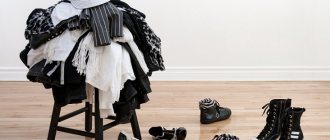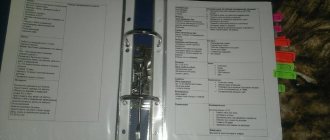/Order/
Author of the article: Sharapova Valeria
It's been several years since the little blue book about cleaning took the world by storm and inspired millions of people to make positive changes in their homes and lives. However, cleaning is not quite the right word. Marie Kondo's book is not about tidying, but rather about tidying up, relating to things, and how space can affect a person's personal well-being. This guide to the KonMari method is intended for those who are already familiar with Magic Tidying Up and need a cheat sheet for the future, as well as for those who are still thinking about purchasing. The guide is supplemented with a selection of inspiring photos, videos, tips on where to donate unnecessary things, as well as notes from a former hoarder - the author of the article.
Despite the fact that I work as an interior journalist and simply adore comfort, I have never been a neat person. Putting things in their place, folding clothes in piles and getting rid of unnecessary things on time - all these were not natural habits for me, but painful rules that I broke every now and then. After extensive cleaning, my apartment always returned to its previous state within a week. That’s why, when I heard about Marie Kondo, who promised to teach me how to tidy up once and for all, I bought her book. Here's what I learned and what came of it.
Cloth
- It is optimal to carry out a wardrobe audit in the following order:
- Tops (shirts, sweaters, etc.);
- Bottoms (skirts, trousers, etc.);
- Clothes that need to be hung on hangers;
- Socks;
- Underwear;
- Bags;
- Accessories (belts, hats, scarves, etc.);
- Special clothing (swimsuits, sportswear, etc.);
- Shoes.
- It is better to fold/hang things of the same category according to the principle from heavy-dark-long to lighter and lighter. For example, things can be sorted by materials such as “wool” and “cotton”. In the drawers, light and light things should be in the front so that your wardrobe makes you happy.
- Use the bag-in-bag method (no more than 1-2 bags in one bag). At the same time, the bag straps should be visible from the outer bag so that you do not forget about them. It is also desirable that the outer and inner bags are similar in material, season and/or style. Thanks to this trick, you will save space and maintain the shape of your accessories.
- Even fold socks and tights into rectangles. Place them all together in a box or drawer in an upright position so you can see each pair. As Marie says, “Treat your socks with respect.”
- Cup bras should be placed carefully next to each other to ensure they maintain their shape. Soft bras should be folded in half and then folded over the straps. Store your bras in a nice basket, like rattan. After all, everything that comes into contact with the body must be kept with special respect.
- If you have a shoe rack, place heavier shoes on the bottom and lighter shoes on top. Then arrange the pairs by color to keep everything organized.
The right furniture is the basis for proper storage
Marie Kondo developed the storage method in her homeland, Japan. It should be noted that in this country real estate has a very high cost. Many average Japanese people live their entire lives in very small apartments and houses. At the same time, the residents of this country are very sensitive to their own homes. Many Japanese believe that proper organization of space and proper interior design will help them achieve success in various areas of life. Minimalism is very popular in Japan - this style involves the rejection of excess and abundance of details. Marie Kondo suggests using built-in cabinets for storage. According to the author of “Magic Cleaning,” dressers with drawers are the most convenient for organizing internal contents. It is worth noting that this system is relevant for small premises (traditional in Japan). In Russia, the most popular are wardrobes filled with shelves and crossbars. Even if you really like the KonMari system, you shouldn’t rush to order cabinets according to Japanese standards. Any closet can be modified to suit your needs by adding new shelves, baskets and boxes, convenient organizers and dividers. You can even build chests of drawers into large wardrobes.
Books
- If there are too many books, they can be sorted into subcategories in the following order:
- Fiction;
- Applied books;
- Illustrated, for example, art albums;
- Magazines.
- When sorting out books, do not start reading them, as this almost always delays cleaning.
- By and large, only those books that belong in your “hall of fame” will remain in your home. For example, Marie herself keeps only 30 books in her house, although she previously had a large library.
- According to Kondo, unread books will never be read. They also tend to accumulate. Therefore, you need to get rid of them.
View this post on Instagram











